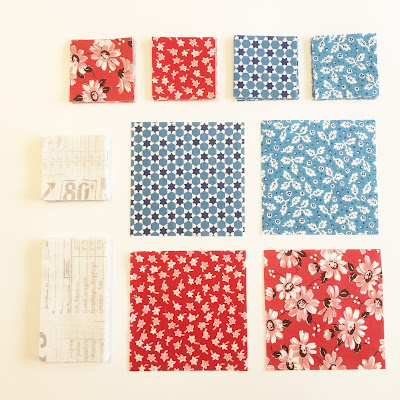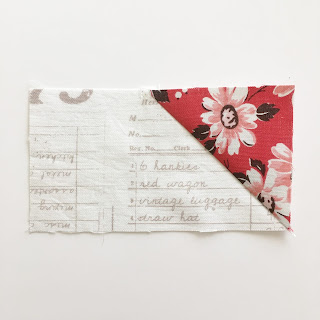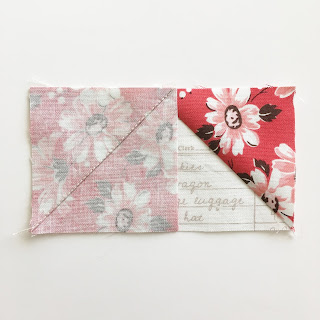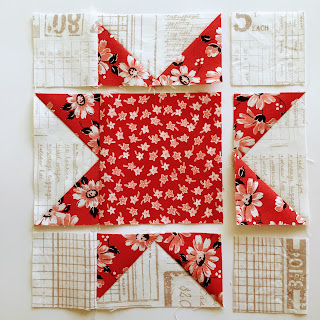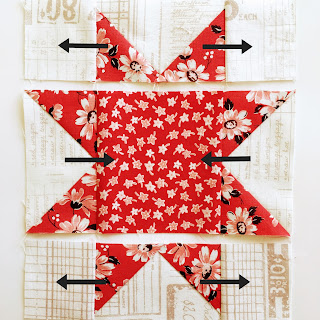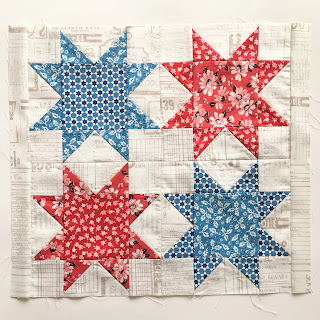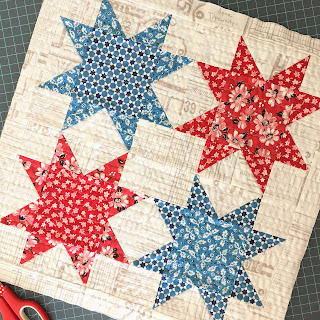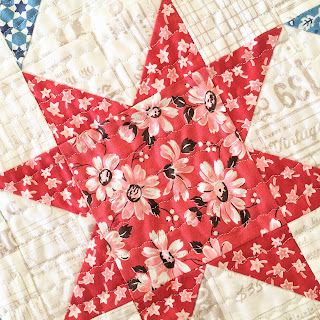Throw pillows are a quick and easy way to update your seasonal decor. This one is perfect for the summer holidays - Memorial Day, Flag Day, 4th of July - but you could also make it with alternate colors for other holidays as well. It has four Sawtooth star blocks made from four fat quarters for the front (you could also easily use scraps for the stars) and finishes at around 18" square. If you'd like to make one like mine, I'll link to the fabrics at the bottom of this post. Here's how to make it:
MATERIALS NEEDED
Stars - (2) red fat quarters and (2) blue fat quarters (or scraps)
Background - 1/3 yd. cream or low volume print
Pillow back - gray fat quarter for solid pillow back OR 5/8 yd gray for envelope back
20" Square of fusible or thin batting
18" pillow insert or stuffing
10" design board (optional but helpful for piecing the stars)
CUTTING
From each red and blue fabric -
Cut (1) 4.5" square
Cut (8) 2.5" squares
From cream background fabric-
Cut (2) 2.5" x 20" strips and subcut into (16) 2.5" squares
Cut (2) 4.5" x 20" strips and subcut into (16) 2.5" x 4 1/2" rectangles
Cut (2) 1.5" x 18.5" strips (not shown)
Cut (2) 1.5" x 16.5" strips (not shown)
MAKE STAR BLOCKS
For each star block:
Points - Make four "Flying Geese" units using the sew-and-flip method as shown:
Layout block like this.
SEW PILLOW TOP TOGETHER
Sew blocks together, press, then sew 1.5" x 16.5" border strips on sides. Press side strips outward, then sew 1.5" x 18.5" strips to top and bottom. Press those outward.
Fuse or baste your pillow front to your batting. I didn't feel the need to add a backing layer because it wouldn't be seen and quilted just fine. I quilted horizontal lines using a narrow stretch zigzag stitch approx. 3/4" apart.
For solid pillow back - from your pillow back fabric, cut a square the same size as the front, pin and sew around all four sides leaving a 12" opening at the bottom. Turn right sides out, stuff with pillow form or stuffing and whipstitch closed.
For envelope back - cut two pieces 24" x the width of your pillow (for example 24" x 18"). On each piece, fold one shorter side under 1" and press, then turn 1" again and press, and sew seam across the fold.
Place one of the pieces at the top of the pillow matching corners and raw edges (sewn edge will be toward the middle), pin in place.
Place the other piece at the bottom of the pillow matching corners and raw edges (sewn edge toward the middle and overlapping the top piece). Pin in place and sew all 4 outside seams.
Turn right sides out and insert pillow form. Here's how the back will look finished:
Hope you enjoyed this tutorial and make one for yourself!
As promised, here are links to the fabrics that I used:
Fat-quarter bundle for Stars and pillow back (if making solid pillow back)
Cream text fabric for background
Gray tulip fabric for envelope pillow back


